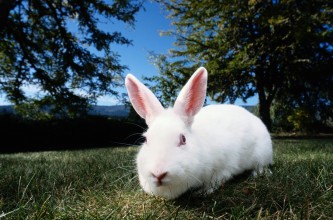Modern Christians celebrate Easter as the anniversary of Jesus’ rebirth, but it wasn’t always so. Like many Christian holidays, Easter has its roots in pre-Christian pagan legend.
Even the word ‘Easter’ comes from the name of an Anglo-Saxon goddess. Her festival of rebirth was celebrated on the vernal equinox, and her name, “Eastre” or “Eostre,” (depending on which scholar you believe) is the root of our English word “estrogen,” so fertility is obviously a key component of the holiday’s history.
The goddess’s chief emblems were the hare– probably since rabbits tend to breed like, well, rabbits; and the egg, which symbolized the cosmic circle of creation. Obviously, with this combination, the Easter Bunny was an inevitability.
When Christianity came on the scene, these springtime symbols were quickly adopted by the new faith.
Easter was “officially” designated a Christian holiday by decree of Emperor Constantine at the Council of Nice in 325 AD. Not incidentally, Constantine also ordered his subjects to wear their best clothes on the holy day; a tradition we still keep by wearing our Sunday best to watch an Easter parade.
The first account of an Easter Bunny we might recognize didn’t come until the late 1600’s. Then, German folk literature mentioned a mysterious, poor, old woman who hid eggs for hungry children to find. If she was spotted by the kids, the woman turned into a giant white rabbit and quickly darted from view. By the time the Easter Bunny hopped the Atlantic to land on American shores in the late 1700’s, the woman had faded from the story altogether and the gifts had gotten more ornate. The sons and daughters of the Germans who settled in what is now Pennsylvania Dutch country eagerly awaited the coming of the Oschter Haws (Easter bunny). Kids built “nests” in family gardens using caps and bonnets. If they were good (always a requirement, I suppose), the Oschter Haws would leave these nests full of pastries and pastel-colored candies. As time wore on, marshmallows and chocolate bunnies started showing up, and the basket soon replaced the bonnet to give us the very popular green plastic grass “nest” we know and sort of love today.
Along the way to cultural dominance, the Easter Bunny had competition for the hearts of America’s kids: Beatrix Potter’s Peter Rabbit, Bambi’s Thumper, and Mary Chase’s Pulitzer Prize-winning Harvey all had their charms. Roger and Jessica Rabbit were hot for a while. There was that pink bunny battery company mascot that keep going and going and going…

But no pretenders to the throne came close to touching the Easter Bunny’s popularity. Except, perhaps, one-the one from Fritz Freleng’s and Mel Blanc’s ‘Legend of Leporidae’, that ‘Wascally Wabbit’, the ‘Rare Hare of Flair’ himself; Mr. Bugs Bunny. Sadly for the Easter Bunny, his multi-millennia reign as hare supreme seems to have come to a close for a time. Bugs is the biggest. (I mean come on. The Easter Bunny is cool and all, but has he ever played basketball with Michael Jordan?)
But Bugs, being a superstar, has an entire staff prepared to care for his every need. Real rabbits aren’t so lucky. Public awareness is growing about the foolishness of giving bunnies as Easter gifts, but it bears repeating: real rabbits don’t make good pets for small children. The careless play of youngsters doesn’t suit the sensitive and physically fragile creatures. Kids need to cuddle their critters, and the domesticated rabbit has a delicate spine easily fractured even by something that seems as harmless as a hug from a toddler’s arms.
Like any pet, rabbits require lifelong commitment. They are gentle, funny companions and make especially good matches for apartment dwellers, but they do require as much, if not more attention than cats and dogs do.
If you are interested in adopting your own Easter bunny, learn all the facts of rabbit companionship at www.rabbit.org.
For the Best that Pet Lifestyle and Animal Welfare has to offer follow Wendy Diamond on Facebook, Twitter, and right here at AnimalFair.com!
